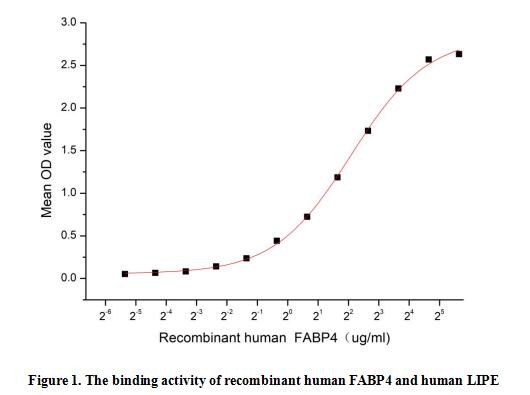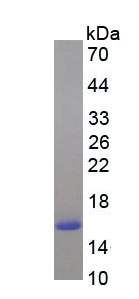Active Fatty Acid Binding Protein 4 (FABP4) 

A-FABP; AFABP; AP2; Fatty Acid Binding Protein 4, Adipocyte; Adipocyte Protein 2; Adipocyte-type fatty acid-binding protein
- UOM
- FOB US$ 216.00 US$ 540.00 US$ 1,080.00 US$ 3,240.00 US$ 8,100.00
- Quantity
Overview
Properties
- Product No.APB693Hu61
- Organism SpeciesHomo sapiens (Human) Same name, Different species.
- ApplicationsCell culture; Activity Assays.
Research use only - DownloadInstruction Manual
- CategoryMetabolic pathwayEndocrinologyCardiovascular biologyHepatology
- Buffer FormulationPBS, pH7.4, containing 0.01% SKL, 5% Trehalose.
- Traits Freeze-dried powder, Purity > 90%
- Isoelectric Point6.8
Sign into your account
Share a new citation as an author
Upload your experimental result
Review

Contact us
Please fill in the blank.
Activity test

Fatty acid binding protein-4 (FABP4) is a member of a large superfamily of lipid binding proteins that are expressed in a tissue specific manner. FABP4 is one of ten cytoplasmic FABPs that are 14-15 kDa in size and range from 126-140 amino acids (aa) in length. Although all are highly conserved in their tertiary structure, there is only modest aa identity between any two members. Lipase, Hormone Sensitive (LIPE) has been identified as an interactor of FABP4, thus a binding ELISA assay was conducted to detect the interaction of recombinant human FABP4 and recombinant human LIPE. Briefly, FABP4 were diluted serially in PBS, with 0.01% BSA (pH 7.4). Duplicate samples of 100 ul were then transferred to LIPE-coated microtiter wells and incubated for 1h at 37℃. Wells were aspirated and incubated for 1h with anti-FABP4 mAb, then aspirated and washed 3 times. After incubation with HRP labelled secondary antibody, wells were aspirated and washed 5 times. With the addition of substrate solution , wells were incubated 15-25 minutes at 37℃. Finally, add 50 µL stop solution to the wells and read at 450 nm immediately. The binding activity of FABP4 and LIPE was shown in Figure 1, and this effect was in a dose dependent manner. The EC50 for this effect is 4.23 ug/mL.
Usage
Reconstitute in 10mM PBS (pH7.4) to a concentration of 0.1-1.0 mg/mL. Do not vortex.
Storage
Avoid repeated freeze/thaw cycles. Store at 2-8°C for one month. Aliquot and store at -80°C for 12 months.
Stability
The thermal stability is described by the loss rate. The loss rate was determined by accelerated thermal degradation test, that is, incubate the protein at 37°C for 48h, and no obvious degradation and precipitation were observed. The loss rate is less than 5% within the expiration date under appropriate storage condition.
Increment services
-
 BCA Protein Quantification Kit
BCA Protein Quantification Kit
-
 Molecular Mass Marker for Protein
Molecular Mass Marker for Protein
-
 Monoclonal Antibody Customized Service
Monoclonal Antibody Customized Service
-
 Polyclonal Antibody Customized Service
Polyclonal Antibody Customized Service
-
 Protein Activity Test Experiment Service
Protein Activity Test Experiment Service
-
 Electrophoretic Mobility Shift Assay (EMSA) Experiment Service
Electrophoretic Mobility Shift Assay (EMSA) Experiment Service
-
 Buffer
Buffer
-
 Lentivirus Packaging Experiment Service
Lentivirus Packaging Experiment Service
-
 Adenovirus Packaging Experiment Service
Adenovirus Packaging Experiment Service
-
 Real Time PCR Experimental Service
Real Time PCR Experimental Service
-
 Spike RBD Protein (S-RBD)
Spike RBD Protein (S-RBD)
-
 Protein G
Protein G
-
 Protein A
Protein A
Citations
- Enhanced A-FABP expression in visceral fat: potential contributor to the progression of NASHPubMed: 23091808
- Siesta is associated with reduced systolic blood pressure level and decreased prevalence of hypertension in older adultsPubMed: 26134622
- Overexpression of the A-FABP gene facilitates intermuscular fat deposition in transgenic micePubMed: 25867423
- Cranberries (Oxycoccus quadripetalus) inhibit lipid metabolism and modulate leptin and adiponectin secretion in 3T3-L1 adipocytesPubMed: 25952883
- Increased expression of fatty acid binding protein 4 in preeclamptic Placenta and its relevance to preeclampsiaPubmed:26992681
- Valproate acid (VPA)-induced dysmetabolic function in clinical and animal studies.pubmed:28161274
- Changes of Plasma FABP4, CRP, Leptin, and Chemerin Levels in relation to Different Dietary Patterns and Duodenal-Jejunal Omega Switch Surgery in Sprague …Pubmed:29849871
- Lack of pronounced changes in the expression of fatty acid handling proteins in adipose tissue and plasma of morbidly obese humansPubmed:29335416
- 25-HC promotes hepatocellular carcinoma metastasis through up-regulation of TLR4 dependent FABP4Pubmed: 31720079
- Water Specific MRI T1 Mapping for Evaluating Liver Inflammation Activity Grades in Rats With Methionine‐Choline‐Deficient Diet‐Induced Nonalcoholic Fatty Liver …Pubmed:35212074
- The Effect of Mineralocorticoid Receptor 3 Antagonists on Anti-Inflammatory and Anti-Fatty Acid Transport Profile in Patients with Heart FailurePubmed:35455943
- FABP4 secreted by M1-polarized macrophages promotes synovitis and angiogenesis to exacerbate rheumatoid arthritisPubmed:35729106









